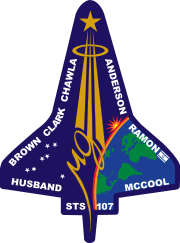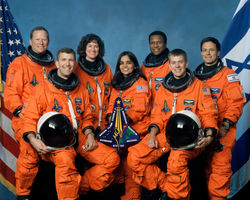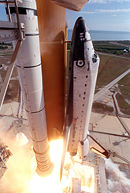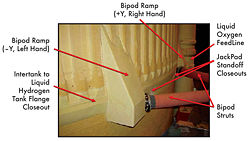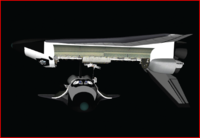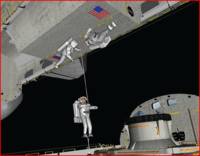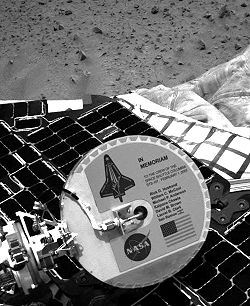Space Shuttle Columbia disaster
2008/9 Schools Wikipedia Selection. Related subjects: Engineering; Space transport
The Space Shuttle Columbia disaster occurred on February 1, 2003, when the Space Shuttle Columbia disintegrated over Texas during re-entry into the Earth's atmosphere, with the loss of all seven crew, shortly before it was scheduled to conclude its 28th mission, STS-107.
The loss of the Columbia was a result of damage sustained during launch when a piece of foam insulation the size of a small briefcase broke off the Space Shuttle external tank (the main propellant tank) under the aerodynamic forces of launch. The debris struck the leading edge of the left wing, damaging the Shuttle's thermal protection system (TPS). While Columbia was still in orbit, some engineers suspected damage, but NASA managers limited the investigation on the grounds that little could be done even if problems were found.
NASA's Shuttle safety regulations stated that external tank foam shedding and subsequent debris strikes upon the Shuttle itself were safety issues that needed to be resolved before a launch was cleared, but launches were often given the go-ahead as engineers unsuccessfully studied the foam shedding problem. The majority of Shuttle launches recorded such foam strikes and thermal tile scarring in violation of safety regulations. During re-entry of STS-107, the damaged area allowed the hot gases to penetrate and destroy the internal wing structure, eventually causing the in-flight breakup of the vehicle. A massive ground search in parts of Texas, Louisiana and Arkansas recovered crew remains and many vehicle fragments.
The Columbia Accident Investigation Board's recommendations addressed both technical and organizational issues. The Space Shuttle program was set back over two years by the disaster, a delay comparable only to that resulting from the Challenger disaster. Concurrently, construction of the International Space Station was put on hold, and the station relied entirely on the Russian Federal Space Agency for resupply and crew rotation until STS-114.
Crew
- Commander: Rick D. Husband, a US Air Force colonel and mechanical engineer, who piloted a previous shuttle during the first docking with the International Space Station ( STS-96).
- Pilot: William C. McCool, a US Navy commander
- Payload Commander: Michael P. Anderson, a US Air Force lieutenant colonel and physicist who was in charge of the science mission.
- Payload Specialist: Ilan Ramon, a colonel in the Israeli Air Force and the first Israeli astronaut.
- Mission Specialist: Kalpana Chawla, an Indian-born aerospace engineer on her second space mission.
- Mission Specialist: David M. Brown, a US Navy captain trained as an aviator and flight surgeon. Brown worked on a number of scientific experiments.
- Mission Specialist: Laurel Clark, a US Navy captain and flight surgeon. Clark worked on a number of biological experiments.
Debris strike during launch
At approximately 82 seconds after launch, a suitcase-size piece of thermal insulation foam broke off the External Tank (ET), striking Columbia's left wing Reinforced Carbon-Carbon (RCC) panels. This likely created a 6 to 10 inch (15 to 25 cm) diameter hole, allowing hot gasses to enter the wing when Columbia later reentered the atmosphere. At the time of the foam strike, the orbiter was at an altitude of about 66,000 feet (20,115 meters), traveling at Mach 2.46 (1,870 mph, or 837 meters per second). The foam fragment was about 1.2 pounds (0.54 kg) in mass and impacted the wing at roughly 800 feet per second (244 meters per second).
The Left Bipod Foam Ramp is an approximately three-foot (one-meter) piece made entirely of foam, as opposed to being a metal structure coated with foam. As such, the foam, not normally considered to be a structural material, is required to bear some aerodynamic loads. Because of these special requirements, the casting-in-place and curing of the ramps may be performed only by a senior technician. The shuttle's main fuel tank is covered in foam as an insulator, to avoid ice forming on it when full of liquid hydrogen and oxygen, which itself could damage the shuttle when shed during lift-off.
Bipod Ramp insulation had been observed falling off, in whole or in part, on many previous flights- STS-7 (1983), STS-27 (1988), STS-32 (1990), STS-50 (1992), plus subsequent flights ( STS-52 and -62) showing partial losses. In addition, Protuberance Air Load (PAL) foam has also shed pieces, plus spot losses from large-area foams. At least one previous strike caused no serious damage. NASA management came to refer to this phenomenon as "foam shedding." As with the O-ring erosions that ultimately doomed the Challenger, NASA management became accustomed to these phenomena when no serious consequences resulted from these earlier episodes. This phenomenon was termed "normalization of deviance" by sociologist Diane Vaughan in her book on the Challenger launch decision process.
Video taken during lift-off of STS-107 was routinely reviewed two hours later and revealed nothing unusual. The following day, higher-resolution film that had been processed overnight revealed the foam debris strike the left wing, potentially damaging the thermal protection on the Space Shuttle. At the time, the exact location where the foam struck the wing could not be determined due to the low resolution of the tracking camera footage.
Mission STS-107 was the 113th Space Shuttle launch. It had been delayed 18 times over the two years from its original launch date of 11 January 2001 to its actual launch date of 16 January 2003. A well-publicized launch delay due to cracks in the shuttle's propellant distribution system occurred one month before a 19 July 2002 launch date, but the Columbia Accident Investigation Board (CAIB) determined that this delay had nothing to do with the catastrophic failure six months later.
Flight risk management
In a risk-management scenario similar to the Challenger disaster, NASA management failed to recognize the relevance of engineering concerns for safety. Two examples of this were failure to honour engineer requests for imaging to inspect possible damage, and failure to respond to engineer requests about status of astronaut inspection of the left wing. Engineering made three separate requests for Department of Defense (DOD) imaging of the shuttle in orbit to more precisely determine damage. While the images were not guaranteed to show the damage, the capability existed for imaging of sufficient resolution to provide meaningful examination. In fact, the CAIB recommended subsequent shuttle flights be imaged while in orbit using ground-based or space-based Department of Defense assets. NASA management did not honour the requests and in some cases intervened to stop the DOD from assisting.
NASA's chief thermal protection system (TPS) engineer was concerned about left wing TPS damage and asked NASA management whether an astronaut would visually inspect it. NASA managers never responded.
Throughout the risk assessment process, senior NASA managers were influenced by their belief that nothing could be done even if damage was detected, hence this affected their stance on investigation urgency, thoroughness and possible contingency actions. They decided to conduct a parametric "what-if" scenario study more suited to determine risk probabilities of future events, instead of inspecting and assessing the actual damage. The investigation report in particular singled out NASA manager Linda Ham for exhibiting this attitude.
Much of the risk assessment hinged on damage predictions to the thermal protection system. These fall into two categories: damage to the silica tile on the wing lower surface, and damage to the reinforced carbon-carbon (RCC) leading-edge panels.
Damage-prediction software, known as "Crater", was used to evaluate possible tile and RCC damage. The software predicted severe penetration of multiple tiles by the impact, but engineers downplayed this, believing that results showing that the software overstated damage from small projectiles meant that the same would be true of larger Spray-On Foam Insulation (SOFI) impacts. The program used to predict RCC damage was based on small ice impacts the size of cigarette butts, not larger SOFI impacts. Under 1 of 15 predicted SOFI impact paths, the software predicted an ice impact would completely penetrate the RCC panel. Engineers downplayed this, too, believing that impacts of the less dense SOFI material would result in less damage than ice impacts. In an e-mail exchange, NASA managers questioned whether the density of the SOFI could be used as justification for reducing predicted damage. Despite engineering concerns about the energy imparted by the SOFI material, NASA managers ultimately accepted the rationale to reduce predicted damage of the RCC panels from complete penetration to slight damage to the panel's thin coating.
NASA managers felt a rescue or repair was impossible, so there was no point in trying to inspect the vehicle for damage while on orbit. However, the CAIB determined either a rescue mission or on-orbit repair, though risky, might have been possible had NASA verified severe damage within five days into the mission.
Ultimately the NASA Mission Management Team felt there was insufficient evidence to indicate that the strike was an unsafe situation, so they declared the debris strike a "turnaround" issue (not of highest importance) and denied the requests for the Department of Defense images.
Destruction during re-entry
The following is a timeline of Columbia's re-entry. The shuttle was scheduled to land at 9:16 a.m. EST.
- 2:30 a.m. EST, Saturday, February 1, 2003 – The Entry Flight Control Team began duty in the Mission Control Centre.
- The Flight Control Team had not been working on any issues or problems related to the planned de-orbit and re-entry of Columbia. In particular, the team had indicated no concerns about the debris impact to the left wing during ascent, and treated the re-entry like any other. The team worked through the de-orbit preparation checklist and re-entry checklist procedures. Weather forecasters, with the help of pilots in the Shuttle Training Aircraft, evaluated landing-site weather conditions at the Kennedy Space Centre.
- 8:00 – Mission Control Centre Entry Flight Director Leroy Cain polled the Mission Control room for a GO/NO-GO decision for the de-orbit burn.
- All weather observations and forecasts were within guidelines set by the flight rules, and all systems were normal.
- 8:10 – The Capsule Communicator notified the crew that they are GO for de-orbit burn.
- 8:15:30 (EI-1719) – Commander Husband and Pilot McCool executed the de-orbit burn using Columbia’s two Orbital Maneuvering System engines.
- The Orbiter was upside down and tail-first over the Indian Ocean at an altitude of 175 statute miles (282 km) when the burn was executed. The de-orbit maneuver was performed on the 255th orbit, and the 2-minute, 38-second burn slowed the Orbiter from 17,500 mph (7.8 km/s) to begin its re-entry into the atmosphere. During the de-orbit burn, the crew felt about 10% of the effects of gravity. There were no problems during the burn, after which Husband maneuvered Columbia into a right-side-up, forward-facing position, with the Orbiter's nose pitched up.
- 8:44:09 (EI+000) – Entry Interface (EI), arbitrarily defined as the point at which the Orbiter enters the discernible atmosphere at 400,000 feet (120 km or 76 mi), occurred over the Pacific Ocean.
- As Columbia descended from space into the atmosphere, the heat produced by air molecules colliding with the Orbiter typically caused wing leading-edge temperatures to rise steadily, reaching an estimated 2,500 degrees Fahrenheit (1,400 °C) during the next six minutes.
- 8:48:39 (EI+270) – A sensor on the left wing leading edge spar showed strains higher than those seen on previous Columbia re-entries.
- This was recorded only on the Modular Auxiliary Data System, and was not telemetered to ground controllers or displayed to the crew.
- 8:49:32 (EI+323) – Columbia executed a pre-planned roll to the right. Speed: Mach 24.5.
- Columbia began a banking turn to manage lift and therefore limit the Orbiter's rate of descent and heating.
- 8:50:53 (EI+404) – Columbia entered a 10-minute period of peak heating, during which the thermal stresses were at their maximum. Speed: Mach 24.1; altitude: 243,000 feet (74 km).
- 8:52:00 (EI+471) – Columbia was approximately 300 miles (500 km) west of the California coastline.
- The wing leading-edge temperatures usually reached 2,650 degrees Fahrenheit (1,450 °C) at this point.
- 8:53:26 (EI+557) – Columbia crossed the California coast west of Sacramento. Speed: Mach 23; altitude: 231,600 feet (70.6 km).

-
- The Orbiter's wing leading edge typically reached more than 2,800 degrees Fahrenheit (1,540 °C) at this point.
- 8:53:46 (EI+597) – Signs of debris being shed were sighted. Speed: Mach 22.8; altitude: 230,200 feet (70.2 km).
- The superheated air surrounding the Orbiter suddenly brightened, causing a noticeable streak in the Orbiter's luminescent trail. Observers witnessed another four similar events during the following 23 seconds.
- 8:54:24 (EI+613) – The Maintenance, Mechanical, and Crew Systems (MMACS) officer informed the Flight Director that four hydraulic sensors in the left wing were indicating "off-scale low." In Mission Control, re-entry had been proceeding normally up to this point.
- "Off-scale low" is a reading that falls below the minimum capability of the sensor.
- The Entry Team continued to discuss the failed indicators.
- "Off-scale low" is a reading that falls below the minimum capability of the sensor.
- 8:54:25 (EI+614) – Columbia crossed from California into Nevada airspace. Speed: Mach 22.5; altitude: 227,400 feet (69.3 km).
- Witnesses observed a bright flash at this point and 18 similar events in the next four minutes.
- 8:55:00 (EI+651) – Nearly 11 minutes after Columbia re-entered the atmosphere, wing leading-edge temperatures normally reached nearly 3,000 degrees Fahrenheit (1,650 °C).
- 8:55:32 (EI+683) – Columbia crossed from Nevada into Utah. Speed: Mach 21.8; altitude: 223,400 ft (68 km).
- 8:55:52 (EI+703) – Columbia crossed from Utah into Arizona.
- 8:56:30 (EI+741) – Columbia initiated a roll reversal, turning from right to left over Arizona.
- 8:56:45 (EI+756) – Columbia crossed from Arizona to New Mexico. Speed: Mach 20.9; altitude: 219,000 feet (67,000 m).
- 8:57:24 (EI+795) – Columbia crossed just north of Albuquerque.
- 8:58:00 (EI+831) – At this point, wing leading-edge temperatures typically decreased to 2,880 degrees Fahrenheit (1,580 °C).
- 8:58:20 (EI+851) – Columbia crossed from New Mexico into Texas. Speed: Mach 19.5; altitude: 209,800 feet (64 km).
- At about this time, the Orbiter shed a Thermal Protection System tile, the most westerly piece of debris that has been recovered. Searchers found the tile in a field in Littlefield, Texas, just northwest of Lubbock.
- 8:59:15 (EI+906) – MMACS informed the Flight Director that pressure readings had been lost on both left main landing-gear tires. The Flight Director then told the Capsule Communicator (CAPCOM) to let the crew know that Mission Control saw the messages and was evaluating the indications, and added that the Flight Control Team did not understand the crew's last transmission.
- 8:59:32 (EI+923) – A broken response from the mission commander was recorded: "Roger, uh, bu - [cut off in mid-word] ..." It was the last communication from the crew and the last telemetry signal received in Mission Control.
- 9:00:18 (EI+969) – Videos made by observers on the ground revealed that the Orbiter was disintegrating. In Mission Control, while the loss of signal was a cause for concern, there was no sign of any serious problem.
- 9:05 – Residents of north central Texas reported a loud boom, a small concussion wave, smoke trails and debris in the clear skies above the counties southeast of Dallas.
- 9:12:39 (EI+1710) – After hearing of reports of the shuttle being seen to break apart, the NASA flight director declared a contingency (events leading to loss of the vehicle) and alerted search and rescue teams in the debris area. He told the Ground Controller to "lock the doors", and two minutes later put Mission Control contingency procedures into effect. Nobody was permitted to enter or leave the room, and flight controllers had to preserve all the mission data for later investigation.
Response from the President
At 14:04 EST (19:04 UTC), President George W. Bush addressed the United States: "This day has brought terrible news and great sadness to our country... The Columbia is lost; there are no survivors." Despite the disaster, the President assured Americans that the space program would continue: "The cause in which they died will continue. Our journey into space will go on."
Recovery of debris
More than 2,000 debris fields, including human remains, were found in sparsely populated areas southeast of Dallas from Nacogdoches in East Texas, where a large amount of debris fell, to western Louisiana and the southwestern counties of Arkansas. NASA issued warnings to the public that any debris could contain hazardous chemicals, that it should be left untouched, its location reported to local emergency services or government authorities, and that anyone in unauthorized possession of debris would be prosecuted. Because of the widespread area, volunteer amateur radio operators accompanied the search teams to provide communications support.
A group of small (1 mm adult) Caenorhabditis elegans worms, living in petri dishes enclosed in aluminium canisters, survived re-entry and impact with the ground and were recovered weeks after the disaster. The culture was verified as still alive on April 28, 2003. They were part of a Biological Research in Canisters experiment (Principal investigator: Catharine A. Conley of NASA Ames Research Centre) designed to study the effect of weightlessness on physiology.
Debris Search Pilot Jules F. Mier Jr. and Debris Search Aviation Specialist Charles Krenek died in a helicopter crash that injured three others while they were contributing to the ground search effort.
Some Texas residents recovered some of the debris, ignoring the warnings, and attempted to sell it on the online auction site eBay, starting at $10,000. The auction was quickly removed, but auctions for Columbia merchandise such as programs, photographs and patches, went up dramatically in value immediately following the disaster, creating a surge of Columbia-related listings.
On May 9, 2008 it was reported that data from a disk drive on board Columbia survived the shuttle accident. The drive was used to store data from an experiment on the properties of shear thinning. Although part of the 340MB drive was damaged, the area that contained the data was unharmed. Because the computer using the drive on board Columbia was running a DOS filesystem, all of the data had been written to the drive in sequence; whereas a modern-day operating system may have scattered the information around the drive for performance reasons.
Onboard video
One item recovered from the debris field was a videotape recording made by the astronauts during the start of re-entry. The video recording lasts for thirteen minutes and shows the flight crew astronauts conducting routine re-entry procedures and joking with each other, none of them giving any indication of a problem. The video shows the flight-deck crew putting on their gloves and passing the video camera around in order to take footage of plasma and flames visible outside the windows of the orbiter, and ends approximately four minutes prior to the start of the shuttle's disintegration. On normal flights, the recording would have continued through landing. According to the online introduction given by Scott Altman, the remainder of the tape was destroyed in the accident.
Initial investigation
NASA Space Shuttle Program Manager Ron Dittemore reported that "The first indication was loss of temperature sensors and hydraulic systems on the left wing. They were followed seconds and minutes later by several other problems, including loss of tire pressure indications on the left main gear and then indications of excessive structural heating". Analysis of 31 seconds of telemetry data which had initially been filtered out because of data corruption within it showed the shuttle fighting to maintain its orientation, eventually using maximum thrust from its Reaction Control System jets.
The investigation focused on the foam strike from the very beginning. Incidents of debris strikes from ice and foam causing damage during take-off were already well known, and had actually damaged orbiters, most noticeably during STS-45, STS-27, and STS-87. Tile damage had also been traced to ablating insulating material from the cryogenic fuel tank in the past. The composition of the foam insulation had been changed in 1997 to exclude the use of freon, a chemical that is suspected to cause ozone depletion; while NASA was exempted from legislation phasing out CFCs, the agency chose to change the foam nonetheless. This led to many accusations of environmental pressures leading to the foam strikes. STS-107 used an older "lightweight tank" where the foam was sprayed on to the larger cylindrical surfaces using the newer freon-free foam. However, the bipods were manufactured from BX-250 foam which was excluded from the EPA regulations and did use the original freon formula. The composition change did not contribute to the accident. In any case, the original formulation had shown frequent foam losses, as described above.
Possible emergency procedures
The CAIB determined a rescue mission, though risky, might have been possible provided NASA management took action soon enough. The CAIB determined that had NASA management acted in time, two possible contingency procedures were available: a rescue mission by shuttle Atlantis, and an emergency spacewalk to attempt repairs to the left wing thermal protection.
Rescue
Normally a rescue mission is not possible, due to the time required to prepare a shuttle for launch, and the limited consumables (power, water, air) of an orbiting shuttle. However, Atlantis was well along in processing for a March 1 launch, and Columbia carried an unusually large quantity of consumables due to an Extended Duration Orbiter (EDO) package. The CAIB determined that this would have allowed Columbia to stay in orbit until flight day 30 ( February 15). NASA investigators determined that Atlantis processing could have been expedited with no skipped safety checks for a February 10 launch. Hence if nothing went wrong there was a five-day overlap for a possible rescue.
Repair
NASA investigators determined on-orbit repair by the shuttle astronauts was possible but risky, primarily due to the uncertain resiliency of the repair using available materials.
Columbia did not carry the Canadarm, or Remote Manipulator System, which would normally be used for camera inspection or transporting a spacewalking astronaut to the wing. Therefore an unusual emergency EVA would have been required. While there was no astronaut EVA training for maneuvering to the wing, astronauts are always prepared for a similarly difficult emergency EVA – to close the external tank umbilical doors located on the orbiter underside. During launch these doors are open for the propellant feed lines from the external tank to supply the main engines in the orbiter tail. If they fail to close after jettisoning the external tank, it constitutes a thermal protection breach which would destroy the orbiter upon re-entry. This requires an emergency EVA to close them manually. Similar methods could have reached the shuttle left wing for inspection or repair.
For the repair, the CAIB determined the astronauts would have to use tools and small pieces of titanium, or other metal, scavenged from the crew cabin. These heavy metals would help protect the wing structure and would be held in place during re-entry by a water-filled bag that had turned into ice in the cold of space. The ice and metal would help restore wing leading edge geometry, preventing a turbulent airflow over the wing and therefore keeping heating and burn-through levels low enough for the crew to survive re-entry and bail out before landing. Because the NASA team could not verify that the repairs would survive even a modified re-entry, the rescue option had a considerably higher chance of bringing Columbia's crew back alive.
Columbia Accident Investigation Board
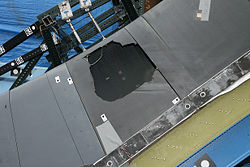
Following protocols established after the loss of Challenger, an independent investigating board was created immediately following the accident. The Columbia Accident Investigation Board, or CAIB, consisted of expert military and civilian analysts who investigated the accident in great detail.
Columbia's flight data recorder was found near Hemphill, Texas on March 20, 2003. Unlike commercial jet aircraft, the space shuttles do not have flight data recorders intended for after-crash analysis. Rather the vehicle data is transmitted in real time to the ground via telemetry. However, since Columbia was the first shuttle, it had a special flight data OEX (Orbiter EXperiments) recorder, designed to help engineers better understand vehicle performance during the first test flights. After the initial Shuttle test-flights were completed, the recorder was never removed from Columbia and was still functioning on the crashed flight. It records many hundreds of different parameters and contained very extensive logs of structural and other data which allowed the CAIB to reconstruct many of the events during the process leading to breakup. Investigators could often use the loss of signals from sensors on the wing to track how the damage progressed. This was correlated with forensic debris analysis conducted at Lehigh University and other tests to obtain a final conclusion about the probable events.
On July 7, 2003 foam impact tests were performed by Southwest Research Institute, which used a foam block of similar size, mass and speed to that which struck Columbia. It created a hole 41 cm by 42.5 cm (16.1 inches by 16.7 inches) in the protective RCC panel. The tests clearly demonstrated that a foam impact of the type Columbia sustained could seriously breach the protective RCC panels on the wing leading edge.
On August 26, the CAIB issued its report on the accident. The report confirmed the immediate cause of the accident was a breach in the leading edge of the left wing, caused by insulating foam shed during launch. The report also delved deeply into the underlying organizational and cultural issues that led to the accident. The report was highly critical of NASA's decision-making and risk-assessment processes. It concluded the organizational structure and processes were sufficiently flawed that compromise of safety was expected no matter who was in the key decision-making positions. An example was the position of Shuttle Program Manager, where one individual was responsible for achieving safe, timely launches and acceptable costs, which are often conflicting goals. The CAIB report found that NASA had accepted deviations from design criteria as normal when they happened on several flights and did not lead to fatal consequences. One of those was the conflict between a design specification stating the thermal protection system was not designed to withstand significant impact damage and the common occurrence of impact damage to it during flight. The board made recommendations for significant changes in processes and culture.
Memorials
On February 4, 2003, President George Bush and his wife Laura led a memorial service for the astronauts' families at the Lyndon B. Johnson Space Centre. Two days later, Vice President Dick Cheney and his wife Lynne led official Washington and the rest of the nation in paying tribute at a similar service at Washington National Cathedral. During that service, singer Patti LaBelle sang "Way up There".
On March 26 the United States House of Representatives' Science Committee approved funds for the construction of a memorial at Arlington National Cemetery for the STS-107 crew. A similar memorial was built at the cemetery for the last crew of Space Shuttle Challenger. On October 28, 2003, the names of the astronauts were added to the Space Mirror Memorial at the Kennedy Space Centre Visitor Complex.
The Houston Astros, who reside in the same city as Johnson Space Center and whose team name honours the U.S. space program, honored the crew on 1 April 2003, the Opening Day of the season, by having seven simultaneous first pitches thrown by family and friends of the Columbia crew. For the National Anthem, 107 NASA personnel, including flight controllers and others involved in Columbia’s final mission, carried a U.S. flag onto the field. In addition, the Astros wore the mission patch on their sleeves and replaced all dugout advertising with the mission patch logo for the entire season.
NASA named several places in honour of Columbia and her crew. Seven asteroids discovered in July 2001 at the Mount Palomar observatory were officially given the names of the seven astronauts: 51823 Rickhusband, 51824 Mikeanderson, 51825 Davidbrown, 51826 Kalpanachawla, 51827 Laurelclark, 51828 Ilanramon, 51829 Williemccool. On Mars, the landing site of the rover Spirit was named Columbia Memorial Station, and included a memorial plaque to the Columbia crew mounted on the back of its high gain antenna. A complex of seven hills east of the Spirit landing site was dubbed the Columbia Hills; each of the seven hills was individually named for a member of the crew, and Husband Hill in particular was ascended and explored by the rover. Back on Earth, NASA's National Scientific Balloon Facility was renamed the Columbia Scientific Balloon Facility.
Other tributes included the decision by Amarillo, Texas to rename its airport Rick Husband Amarillo International Airport, after its native son and commander of STS-107. State Route 904 was renamed Lt. Michael P. Anderson Memorial Highway, as it runs through Cheney, Washington - the town where he graduated from high school. A mountain peak near Kit Carson Peak and Challenger Point in the Sangre de Cristo Range was renamed Columbia Point, and a dedication plaque was placed on the point in August 2003. Buildings or classrooms were named in honour of Columbia crewmembers at the Florida Institute of Technology, Creighton University, The University of Texas at Arlington, and the Columbia Elementary school in the Brevard County School District. The Huntsville City Schools in Huntsville, Alabama, a city strongly associated with NASA, named their most recent high school Columbia High School as a memorial to the crew. A Department of Defense school in Guam was re-named Commander William C. McCool Elementary School. The City of Palmdale, the birthplace of the entire shuttle fleet, renamed a major thoroughfare Avenue M to Columbia Way after the disaster in honour of the lost shuttle and its crew.
NASA later named a supercomputer "Columbia" in the crew's honour.
A US Navy compound at a major coalition military base in Afghanistan is named Camp McCool in honour of Commander William C. McCool.
Impact for space programs
Following the loss of Columbia, the space shuttle program was suspended. The further construction of the International Space Station was also delayed, as the space shuttles were the only available delivery vehicle for station modules. The station was supplied using Russian unmanned Progress ships, and crews were exchanged using Russian-manned Soyuz spacecraft, and forced to operate on a skeleton crew of two.
In late July 2003, an Associated Press poll revealed that Americans' support for the space program remained strong. Two-thirds believed the space shuttle should continue to fly and nearly three-quarters said that the space program was a good investment. On the question of sending humans to Mars, 49% thought it was a good idea, while 42% opposed it. For sending civilians like teachers into space, 56% supported the idea and 38% opposed.
Less than a year after the accident, President Bush announced the Vision for Space Exploration, calling for the retirement of the space shuttle fleet following the completion of the International Space Station and the development of the Crew Exploration Vehicle. NASA planned to return the space shuttle to service around September 2004. That date was pushed back to July 2005. On July 26, 2005, at 10:39 a.m. EST, Space Shuttle Discovery cleared the tower, marking NASA's return to space. Overall the STS-114 flight was highly successful, but a similar piece of foam from a different portion of the tank was shed, although the debris did not strike the Orbiter. Due to this, NASA once again grounded the shuttles until the problem was solved. After delaying their re-entry by two days due to adverse weather conditions, the shuttle safely returned to Earth on August 9, 2005.
Later that same month, the external tank construction site, Michoud Assembly Facility located in New Orleans, Louisiana was damaged by Hurricane Katrina, with all work shifts cancelled up to September 26, 2005. At the time, there was concern that this would set back further Shuttle flights by at least two months and possibly more.
The second "Return to Flight" mission, STS-121, launched on July 4, 2006, at 2:37:55 PM (EDT), after two previous launches were scrubbed because of lingering thunderstorms and high winds around the launch pad and the launch took place despite objections from its chief engineer and safety head. This mission increased the ISS crew to three. A five-inch (127 mm) crack in the foam insulation of the external tank gave cause for concern; however, the Mission Management Team gave the go for launch. Space Shuttle Discovery touched down successfully on July 17, 2006 at 9:14:43 AM (EDT) on Runway 15 at the Kennedy Space Centre.
On August 13, 2006, NASA announced STS-121 had shed more foam than they expected. While this did not delay the launch for the next mission, STS-115, originally set to lift off on August 27, the weather and other technical glitches did, with a lightning strike, Hurricane Ernesto and a faulty fuel tank sensor combining to delay the launch until September 9. On September 19, landing was delayed an extra day to examine Atlantis after objects were found floating near the shuttle in the same orbit. When no damage was detected, Atlantis landed successfully on September 21.
